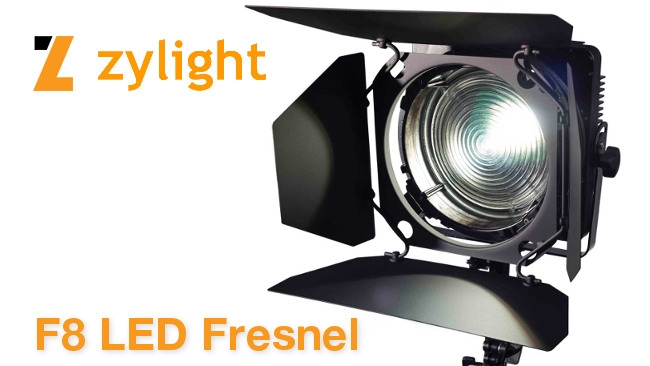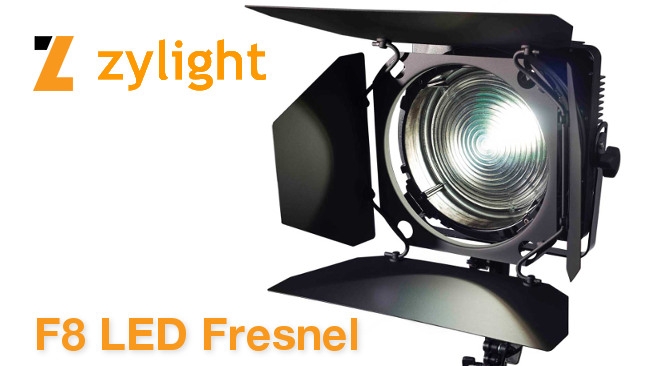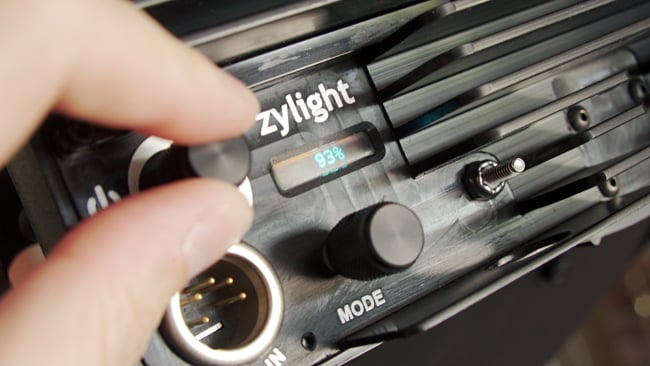
 Zylight F8 LED Fresnel
Zylight F8 LED Fresnel
Phil Rhodes recently had the chance to test Zylight's F8 LED fresnel and discovered some innovations that may differentiate it from the competition.
With its LED fresnel already demonstrated at NAB, it might seem a little behind the times to be looking at Zylight's hundred-watt F8. Even with such rapid advancement in the field, however, the original F8 is still a recent device. Notably, it's an early example of quantum dot LED technology, a development that we've written about in detail, which in general allows the production of fluorescent materials that glow with a colour that can be easily and finely tuned. Since white-emitting solid state lights rely on exciting a fluorescent material using a blue-emitting LED device, the ability to create a glow of any desired colour is crucially important to good colorimetry, and it's colorimetry that's the principal technical objection to LED.
How design sets the Zylight F8 apart
The Zylight F8 enjoys the benefits of this technology, but there are some other things about the design that make it stand out. The key thing to like about Zylight's fresnel is that it isn't simply a retooling of the traditional cylindrical fresnel design, as many competing devices are. The traditional fresnel shape exists because of the need for a reflector in a traditional HMI or tungsten-powered device. These optical requirements don't exist for LEDs, which intrinsically emit in only one direction (or at least the final packaged devices do). The F8's layout takes advantage of this, collapsing down to a fairly flat-packed, rectilinear shape that stores easily and minimises the space penalty in transportation. It probably occupies a bit more than half the volume of a more traditional design, but is considerably easier to store than that comparison suggests.
About output
Zylight claims that the light output of the F8, the daylight version, is equivalent to a 1000W fresnel. A good rule of thumb is to consider that the average white LED will have an efficiency (strictly, a luminous efficacy) about four or five times that of tungsten in the range of wavelengths we care about. Quantum dots are a little better, but the purpose of the technology is really to control colour, not maximise output. As such, we would expect the kilowatt claim to be overstated by about a stop, which corresponds at least broadly to reality, although the device is still a lot more powerful than otherwise equivalent tungsten and the behaviour is not entirely comparable in either case. A hundred-watt light is more or less the largest that can reasonably be run from camera batteries, however, which is a useful option that becomes a little less practical on the upcoming 200-watt version.
One benefit of LED is that it can be dimmed without compromise to colour rendering, a feature which Zylight facilitates either locally, via DMX, or radio control. The onboard dimming operates from zero to 100% in one-percent intervals.

There is a minor problem with nonlinearity; the difference between 1% and 2% is quite large, whereas the difference between 99% and 100% is much smaller. It seems likely that the electronics assume a degree of linearity from the LED emitter that isn't there, which affects the subtlety with which output can be trimmed, especially at low levels. It would have been nice to have seen a more visually linear representation here in a device aimed at the top of the market.
Fresnel lights are not, optically speaking, particularly efficient. Considerable amounts of light strike the inside of the assembly and are wasted, particularly at narrower zoom angles, and the F8 is not immune to this issue. That said, the rubber bellows around the zoom action (contributing to the unit's waterproof rating) are a large part of why it can fold down into such a small package.
The overall build quality is high. Zylight has made the F8, to be frank, out of big lumps of metal. Without wanting to suggest that it's overbuilt, the overall impression is one of sturdiness. The output characteristic is similar to that from any fresnel, although the lens controls chromatic aberration in the edges unusually well. The eight-inch lens feels a little larger than would be normal on a fresnel of this order of output, which helps with both efficiency and beam quality. This is another benefit of the optical setup that works best for LED.
Operation and CRI
In operation, the benefits of solid-state light quickly become apparent. While the F8's rear-mounted heatsink fins do become very warm in use, the ratio of heat to light is at least as good as HMI. The light doesn't have many of the problems associated with metal halide lighting; there is no problem with hot restarting, no sound and no flicker, at least at conventional frame rates (the company specifies the pulse-width rate at 11.8KHz, which will be flicker free at any but the highest frame rates, although a true DC drive would have been better). If there are any problems, they are similar to those of any LED: it's short of deep red and cyan-green colours. The F8-D is rated at 95 CRI, although we have long been cautious about the application of CRI as a metric for the evaluation of highly discontinuous spectra, such as that produced by white-emitting LEDs. The TLCI evaluation, however, produces an excellent result of 92. The TLCI spec suggests that the "errors are so small that a colourist would not consider correcting them," and that only hue adjustments of cyan-blue colours are really required to correct even the most supercritical material. This is unusually good performance for an LED and goes some way to justifying the price point of Zylight's product, as it can be used without worrying about its colorimetry.
With any luck, the 200W version, which requires fan cooling, unlike the silent F8, will be as good. There's probably no immediate prospect of HMI being displaced from the world of extremely big lights, as even Mole's 900-watt device is only equivalent to perhaps a 5kW tungsten light of the same size, but it's easy to imagine a future in which practically everything is lit with LED.
Zylight F8 is from $2400
Tags: Production


Comments